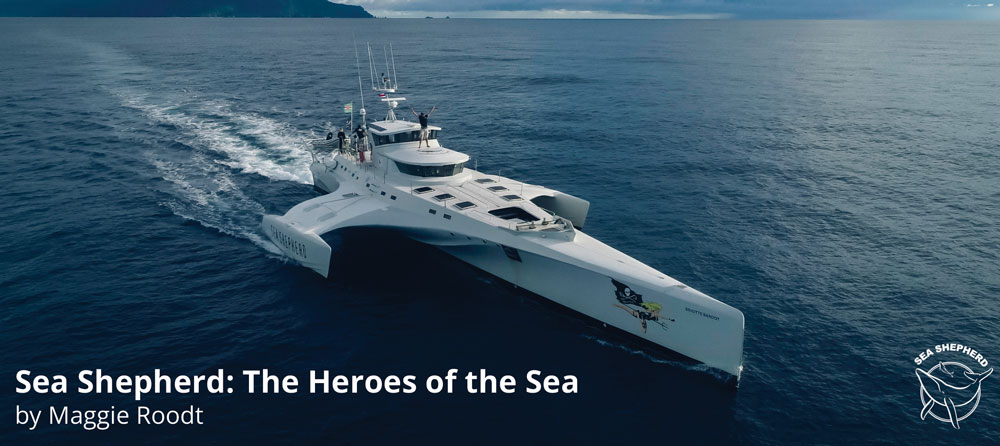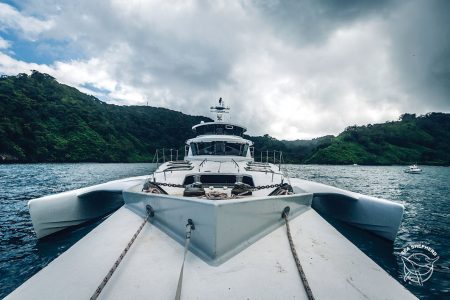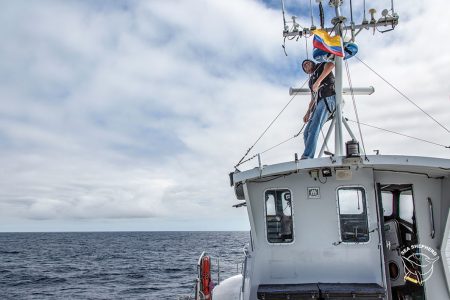Sea Shepherd: The Heroes of the Sea

According to the United Nations, 7% of global fish stocks are depleted, 52% are fully exploited and 17% are over exploited. This leaves only an estimated 20% of worldwide fish stocks that aren’t already at capacity. In addition, 90% of large predatory fish are already gone. Fins from up to 73 million sharks are used in shark fin soup each year. Recent estimates also say that the global by-catch (untargeted marine species caught during commercial fishing and returned to the sea dead) rate may amount to 40% of the world’s catch.

These dire statistics may seem discouraging, but not to everyone. Founded in 1977, Sea Shepherd is an international non-profit marine wildlife conservation organization. They’re active on the ground, on the high seas, and inside the world’s highest courtrooms, dedicated to “ending the destruction of habitat and slaughter of wildlife in the world’s oceans in order to conserve and protect ecosystems and species.”
The Interceptor Vessel
Over December and January, the Marina Pez Vela played host to the M/V Brigitte Bardot, the Sea Shepherd’s interceptor vessel. This crew belongs to the Sea Shepherd Conservation Society chapter, which means they patrol the oceans and take direct action to investigate, document, expose and confront illegal activities on the high seas.
They are currently working on Operation Mamacocha. This campaign covers roughly two million square kilometers (770 000 square miles) of ocean, and addresses Illegal, Unreported and Unregulated (IUU) fishing in the Eastern Tropical Pacific Biodiversity Corridor. These waters are rich in nutrients and play host to 88 species of sharks, giant oceanic manta rays, sea turtles, dolphins, and blue whales among others. We had a chance to chat with their campaign leader Rebecca Benjamin-Carey about what life is like on board.
Who are the people that make up your crew and how do most of them get involved with you?
Currently we have a Captain, First Mate, Second Mate, Engineer, Chef and Media Manager for this campaign on board our vessel. It’s a small boat that can hold up to 12 people and right now we’re only 6. We’ll usually have six or seven members on board during a campaign, so that two people are on watch at all times.
What brings you to Costa Rica?
The Eastern Tropical Pacific Biodiversity Corridor covers the islands of Cocos, Galapagos, Malpelo and Coiba. As a migration path for lots of pelagic species, it’s an ideal location to conduct research. We went to Cocos Island to do research on shark populations, especially endangered species like hammerhead sharks.

How challenging has Operation Mamacocha been so far?
It’s really hard to track seeing as we’re patrolling such a big area. We work with SkyTruth, an organisation that uses satellite imagery to track these boats down, telling us exactly where to go. This means we use their satellite images and overlay them with AIS systems so we know the names of all the boats to easier determine if they’re legal or not.
Your boat, the Brigitte Bardot, is Sea Shepherd’s interceptor vessel. What exactly does that mean?
It means it’s our fast ship. She’s rated to go 30 knots and gives us a fast, manoeuvrable and fuel-efficient way of tracking down poaching vessels. She was originally built for an 80-day sailing trip around the world and we actually broke that record in 74 days, 20 hours, and 58 minutes.
Describe an average day on board the Brigitte Bardot?
On a campaign we either wake up first thing in the morning, in the middle of the day or really late at night, depending on when your shift is. We patrol 24/7 by using the radar to identify and investigate fishing vessels around. Oh and there are three meals a day.
What kind of dishes does the chef usually cook?
All the Sea Shepherd ships are vegan, so she gets really creative. We’ve realized you can have a vegan version of anything you want.
Tell us about your most memorable experience on board?
Aboard the Brigitte Bardot, my favourite memory was during Operation Jairo which involved protecting endangered sea turtles along the shores of Nicaragua, Antigua and Barbuda. Working alongside a group of five scientists from the Antigua Sea Turtle Project, we protected nests and tagged sea turtles. It was the largest research project done in the region. During our very last patrol a scientis noticed that there was a turtle up track, but no track coming down. Upon investigation, we found a turtle that had gotten stuck underneath a ledge. We were able to dig it out and get it back to the sea, ultimately saving that sea turtle’s life. Moments like that are the most rewarding.

What has been the most shocking thing you’ve encountered at sea?
Operation Milagro is focused on conservation efforts to protect the vaquita porpoise, a species on the brink of extinction. We cut and destroy nets that have been illegally placed in refuge zones, so we deal with lots of hostility from poachers because we’re taking away thousands of dollars from them. The worst thing I’ve seen is the number of animals caught in those nets – we’ve found leatherback turtles, stingrays, sharks, dolphins, sea lions and more strangled in the nets. Once we’ve removed the nets, we send it to another organisation that recycles them into material for things like shoes and shirts.
Would you say what you do is dangerous? How do you mitigate the risks?
Yes, definitely. The people we’re facing are operating illegally and it’s all unregulated and unreported. We’re all volunteers and we all know what we signed up for, but we mitigate the risks with passion.
How do you communicate with the outside world while at sea?
We do have satellite WiFi on board, but it’s not really good. We mostly use it if there’s pressing media footage that we need to share.
What are your thoughts on Japan’s recent announcement to restart commercial whaling?
We see Japan leaving the International Whaling Commission (IWC) as a win because that gets them out of the Southern Pacific Whale Sanctuary. Japanese vessels used to disguise themselves as research ships and still conduct whaling in this protected area. Now that they’re out in the open, there will be more eyes on them and make it easier to control where they do it and make sure they don’t do it in the sanctuary. The issue is not gone but we’re definitely getting closer to stopping whaling on a global scale.
What is the most common threat to the aquatic environment that you see?
Over fishing. When IUU vessels head out, they might be targeting one or two fish species, but they have a high by-catch rate and this isn’t being dealt with properly. They’re also leaving millions of pounds of fishing gear discarded in the ocean.
After Costa Rica, where will your crew be headed next?
We’re heading East offshore for about 2 weeks to a month, patrolling for IUU fishing vessels.
You can also get involved with Sea Shepherd on sea, shore or land. All you need to do is apply on their website, seashepherd.org. Alternatively, you can make donations online, all of which goes towards keeping the fleet active. Thank you to the SSCS team for fighting for our seas and thanks to the Marina Pez Vela for facilitating this interview.
